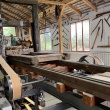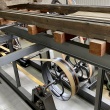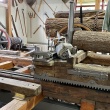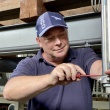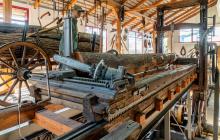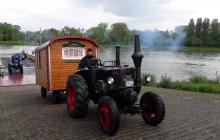20 years ago today, we put our historic gang saw in Sinsheim into operation for the very first time. Since August 24th, 2000, our guests can operate this large-scale saw every day and thus see how timber production worked over 150 years ago. Holger Hamann, who runs our workshop, remembers how the saw came to Sinsheim.
In the end of 1999, the president of the Technik Museen Sinsheim Speyer at the time, Eberhard Layher, came to me and said: “Mister Hamann, I have this old gang saw lying around... A very old and very run-down one. Please take a look at it and see if you can get it up and running.” That is how I ended up with a giant pile of scrap – steel and wood – from 1870. I didn’t even know what it was nor where to start. I had never heard of the term “gang saw” before.

So, I decided to gather some reading material in order to get an idea about these kinds of saws. It turned out that there are about one hundred different types of gang saws and I had no idea how the saw in front of me was supposed to look like when fully assembled. Luckily, back then, there were still a few museums that exhibited those saws, such as this one collection in the Black Forest: they had the exact same saw. We took photos of it and assembled our saw according to these pictures. We arranged the beams and bows in the right way and the holes matched perfectly – so, part by part, we rebuilt the saw. Once you figure out how the parts fit together, it’s just like Lego.
In January/February 2000, we started the saw for the first time. When the president of the museum saw his saw in action, he was thrilled. He had tears in his eyes. Getting the saw up and running seemed to have been a matter very close to his heart. Another advantage of the saw was that it worked independently, without any staff. In a way, it was a little sensation. In every other museum, the saws have to be operated by staff members.

However, we still had to find room for our saw. Until then, we still didn’t know where to place it. We were waiting to see how large is was going to be. It turned out that we didn’t really have room for this 20-metre-long exhibit. We had to expand: we dug off the slope next to Hall 1, cast a concrete slab and placed the saw there. Afterwards, we added the walls and the roof.
We still check on our “old lady” every day – after all, she has been operating several times a day since August 24th, 2000. And even though our saw is from 1870, it could still saw timber today.
Here are some general technological and historical facts about the gang saw:
Except for the and the single saw blade, the whole saw is made of wood. It is powered by hydropower. Until its end of operation, it was used in Geislingen an der Steige, Baden-Wuerttemberg, Germany. You could insert trunks of up to 12 meters of length in order to saw large and heavy beams. At the time, the trunks were manually sawed off in the forest, mostly transported on rivers, and then processed in saw mills. There used to be saw mills along every stream. The saws came in different sizes. The one we have in Sinsheim is a vertical gang saw, whereas others have a horizontal saw blade. You had to move the trunk around multiple times until it was perfectly sawed. With only one saw blade, the operation speed was limited – the hydropower simply wasn’t sufficient for more saw blades. However, due to the invention of steam engines and electric engines, gang saws changed a lot: thanks to the higher number of saw blades, they could now easily saw large beams.
The stories and reports represent the opinions and perspectives of the respective authors. Please note, especially while reading articles about our events, that binding information (e.g. opening hours, admission fees and programme) is only published on the museum's official website www.technik-museum.de.
Please note that the pictures, texts and videos published here are subject to the copyright of the respective authors and / or the museum and may not be used without permission.
Keep up-to-date with new articles
We recommend to subscribe to the museum’s newsletter via e-mail. At the end of each newsletter, we inform you about new articles so that you will not miss any of them. Alternatively, you can subscribe to an RSS feed:
Subscribe to newsletter RSS-Feed (Reader required)

